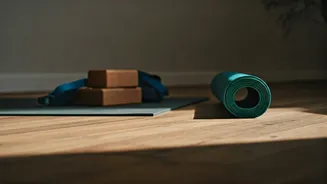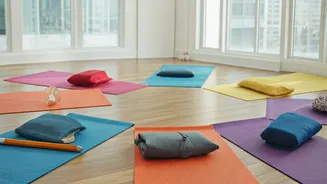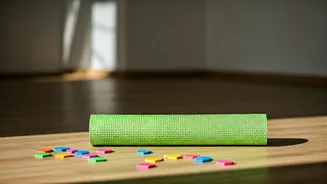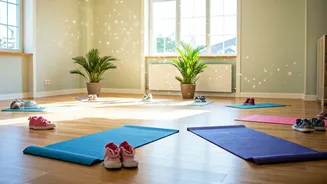Introduction to Yoga
Yoga, an ancient practice, harmonizes the mind and body through postures, breathing exercises, and meditation. For children, yoga offers a fun and effective
method to improve concentration, memory, and emotional regulation. Unlike the often intense workouts that are typical for adults, kid-friendly yoga asanas are designed to be playful and engaging, helping children stay focused while developing physical skills. The asanas promote flexibility, strength, and coordination. Regular practice can instill a sense of calm and self-awareness, which is very helpful in our increasingly hectic lives. Yoga for kids is a holistic approach to nurturing both their physical and mental well-being, paving the way for improved performance in their studies and everyday activities. It also provides children with valuable life skills.
Mountain Pose (Tadasana)
Tadasana, or the Mountain Pose, serves as the foundation for all standing poses and is a powerful starting point for any yoga session. To perform this pose, have the child stand tall with their feet together, ensuring their toes and heels touch. Instruct them to engage their leg muscles, feeling a gentle lift in their kneecaps. They should keep their spine straight, shoulders relaxed, and arms at their sides, palms facing forward. The child must breathe deeply, feeling the stretch in their body and staying grounded. The Mountain Pose enhances body awareness, develops a sense of stability, and cultivates proper posture. It's a great exercise to build focus and instill a sense of calm before diving into more complex asanas.
Tree Pose (Vrikshasana)
Vrikshasana, or the Tree Pose, is excellent for enhancing balance and concentration. To begin, have the child stand in Tadasana. They should shift their weight onto one leg, bending the other knee and placing the sole of the foot on the inner thigh (avoiding the knee). The child must maintain balance by focusing on a fixed point in front of them, breathing steadily. The hands can be raised overhead in a prayer position or extended out to the sides. Tree Pose improves balance, increases focus, and builds strength in the legs. It encourages children to remain steady and composed, even when facing challenges.
Warrior II (Virabhadrasana II)
Virabhadrasana II, the Warrior II Pose, cultivates strength, stamina, and confidence. The child should stand with their legs wide apart, turning one foot outward and the other slightly inward. They must bend the front knee to a 90-degree angle, keeping the knee over the ankle. Extend the arms out to the sides, parallel to the ground, with palms facing down. The child should gaze over the front hand, breathing deeply. Warrior II builds strength in the legs and arms, enhances balance, and promotes a sense of empowerment. This pose helps children feel strong and resolute.
Downward Dog (Adho Mukha Svanasana)
Adho Mukha Svanasana, or Downward-Facing Dog, is a versatile pose that energizes the body while calming the mind. To enter this pose, have the child start on their hands and knees, with hands shoulder-width apart and knees hip-width apart. They should tuck their toes under and lift their hips up and back, forming an inverted V-shape. Keep their hands and feet firmly planted, allowing their head to hang freely between their arms. Downward Dog stretches the entire body, strengthens the arms and legs, and improves circulation. It also promotes a sense of relaxation and focus.
Cobra Pose (Bhujangasana)
Bhujangasana, or the Cobra Pose, is a gentle backbend that stimulates the spine and opens the chest. The child should lie on their stomach with their hands under their shoulders, elbows close to their body. They must gently lift their head and chest off the ground, using their back muscles, keeping the lower body grounded. The child should avoid pushing with their arms too much, instead focusing on the back muscles. Cobra Pose improves posture, strengthens the back muscles, and boosts energy levels. This pose helps build a connection with their own inner strength.
Bridge Pose (Setu Bandhasana)
Setu Bandhasana, the Bridge Pose, is an invigorating backbend that strengthens the back and core. Have the child lie on their back with their knees bent and feet flat on the floor, hip-width apart. Keeping their arms at their sides, the child should lift their hips off the ground, creating a bridge with their body. They can interlace their hands under their back for support. The Bridge Pose strengthens the back, improves digestion, and reduces stress. It is a fantastic pose for invigorating the body and promoting a sense of well-being.
Child's Pose (Balasana)
Balasana, or Child's Pose, is a resting pose that promotes relaxation and calmness. The child should kneel on the floor with their knees together (or slightly apart for comfort) and rest their forehead on the ground. They can stretch their arms forward or place them alongside their body, palms up. Child's Pose gently stretches the hips, thighs, and ankles while relieving stress and fatigue. It is a perfect pose for recharging and feeling grounded, providing a peaceful and restorative state.
Boat Pose (Paripurna Navasana)
Paripurna Navasana, or the Boat Pose, is excellent for strengthening the core and improving balance. The child should sit with their knees bent, feet lifted off the ground, and their torso leaning back slightly. They can hold onto the backs of their knees for support or extend their arms forward parallel to the ground. The Boat Pose strengthens the abdominal muscles, improves balance, and boosts confidence. It encourages the child to engage their core and focus their attention.
Happy Baby Pose (Ananda Balasana)
Ananda Balasana, or the Happy Baby Pose, is a joyful pose that promotes relaxation and releases tension in the hips and lower back. The child should lie on their back, bend their knees toward their chest, and grab the outside of their feet (or ankles if they can't reach their feet). They must gently rock from side to side, feeling the stretch. Happy Baby Pose stretches the inner thighs, hips, and spine while calming the mind. It is a fun and effective way to release stress and foster a sense of joy and well-being, leaving the child feeling relaxed and rejuvenated.











